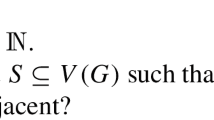Abstract
Unavoidable subgraphs have been widely studied in the context of Ramsey Theory. The research in this area focuses on highly structured graphs such as cliques, cycles, paths, stars, trees, and wheels. We propose to study maximum unavoidable subgraphs measuring the size in the number of edges. We computed maximum unavoidable subgraphs for graphs up to order nine via SAT solving and observed that these subgraphs are less structured, although all are bipartite. Additionally, we found large unavoidable bipartite subgraphs up to order twelve. We also present the concept of multi-component unavoidable subgraphs and show that large multi-component subgraphs are unavoidable in small graphs. We envision that maximum unavoidable subgraphs can be exploited using an alternative approach to breaking graph symmetries.
Access this chapter
Tax calculation will be finalised at checkout
Purchases are for personal use only
Similar content being viewed by others
Notes
- 1.
Currently, our system is not able to prove this property for \(n > 18\) due to out of computational resources.
- 2.
We found multiple maximum unavoidable subgraphs for \(K_9\). Figure 3 (a) shows one of them.
References
Aloul, F.A., Sakallah, K.A., Markov, I.L.: Efficient symmetry breaking for boolean satisfiability. In: Gottlob, G., Walsh, T. (eds.) Proceedings of the Eighteenth International Joint Conference on Artificial Intelligence, IJCAI 2003, Acapulco, Mexico, 9–15 August 2003, pp. 271–276. Morgan Kaufmann (2003)
Audemard, G., Simon, L.: Predicting learnt clauses quality in modern SAT solvers. In: Boutilier, C. (ed.) Proceedings of the 21st International Joint Conference on Artificial Intelligence, IJCAI 2009, Pasadena, California, USA, pp. 399–404, 11–17 July 2009
Bondy, J.A., Erdős, P.: Ramsey numbers for cycles in graphs. J. Combin. Theory Ser. B 14(1), 46–54 (1973)
Burr, S.A., Erdős, P.: Extremal Ramsey theory for graphs. Utilitas Math. 9, 247–258 (1976)
Codish, M., Miller, A., Prosser, P., Stuckey, P.J.: Breaking symmetries in graph representation. In: Proceedings of IJCAI 2013, pp. 510–516. IJCAI/AAAI (2013)
Gerencsér, L., Gyárfás, A.: On Ramsey-type problems. Annales Universitatis Scientiarum Budapestinensis 10, 167–170 (1967)
Graham, R.L., Rothschild, B.L., Spencer, J.H.: Ramsey Theory. A Wiley-Interscience Publication. Wiley, New York (1990)
Harary, F.: Recent results on generalized ramsey theory for graphs. In: Alavi, Y., Lick, D.R., White, A.T. (eds.) Graph Theory and Applications. Lecture Notes in Mathematics, vol. 303, pp. 125–138. Springer, Heidelberg (1972)
Heule, M.J.H., Kullmann, O., Marek, V.W.: Solving and verifying the boolean pythagorean triples problem via cube-and-conquer. In: Creignou, N., Le Berre, D. (eds.) SAT 2016. LNCS, vol. 9710, pp. 228–245. Springer, Switzerland (2016)
Konev, B., Lisitsa, A.: A SAT attack on the Erdős discrepancy conjecture. In: Sinz, C., Egly, U. (eds.) SAT 2014. LNCS, vol. 8561, pp. 219–226. Springer, Heidelberg (2014)
McKay, B.D., Piperno, A.: Practical graph isomorphism, II. J. Symbol. Comput. 60, 94–112 (2014)
McKay, B.D., Radziszowski, S.P.: R(4, 5) = 25. J. Graph Theory 19(3), 309–322 (1995)
Radziszowski, S.P.: Small Ramsey numbers. Electron. J. Combin., #DS1 (2014)
Radziszowski, S.P., Jin, X.: Paths, cycles and wheels in graphs without antitriangle. Australas. J. Combin. 9, 221–232 (1994)
Thurley, M.: sharpSAT – counting models with advanced component caching and implicit BCP. In: Biere, A., Gomes, C.P. (eds.) SAT 2006. LNCS, vol. 4121, pp. 424–429. Springer, Heidelberg (2006)
Acknowledgements
The authors are supported by the National Science Foundation under grant number CCF-1526760 and acknowledge the Texas Advanced Computing Center (TACC) at The University of Texas at Austin for providing grid resources that have contributed to the research results reported within this paper.
Author information
Authors and Affiliations
Corresponding author
Editor information
Editors and Affiliations
Rights and permissions
Copyright information
© 2016 Springer International Publishing Switzerland
About this paper
Cite this paper
Cuong, C.K., Heule, M.J.H. (2016). Computing Maximum Unavoidable Subgraphs Using SAT Solvers. In: Creignou, N., Le Berre, D. (eds) Theory and Applications of Satisfiability Testing – SAT 2016. SAT 2016. Lecture Notes in Computer Science(), vol 9710. Springer, Cham. https://doi.org/10.1007/978-3-319-40970-2_13
Download citation
DOI: https://doi.org/10.1007/978-3-319-40970-2_13
Published:
Publisher Name: Springer, Cham
Print ISBN: 978-3-319-40969-6
Online ISBN: 978-3-319-40970-2
eBook Packages: Computer ScienceComputer Science (R0)




